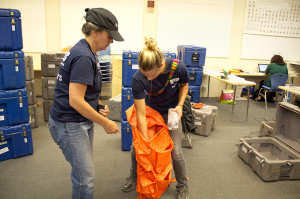Volunteers Help USGS with Warren Hall Experiment
August 22, 2013

Three days before the implosion of Warren Hall, hundreds of volunteers formed teams and worked for hours out in the field, digging to place seismic sensors in the ground, only to dig them back up for data retrieval four days later.
The more than 600 seismographs they placed in the ground are part of a science experiment by the United States Geological Survey. Warren Hall’s demolition provided their team, based in Menlo Park, a historic opportunity to map the dangerous and long overdue Hayward Fault. The last time the fault ruptured in 1868, almost the entire city of Hayward was destroyed.
What makes the fault especially dangerous and difficult to study is that it runs through a populated urban area, where much of the fault is covered by buildings and concrete.
“As a geologist you want to go out and look at rocks, and urban settings almost by definition you don’t have any really good exposures [of the underlying bedrock] to go out and work with,” said Leslie Barnes, an alumna of UC Davis. “Urban settings can be very difficult to work in because there’s so many people you have to talk to, get permissions from, and then get set up and work around the duties.”
The project is one of the largest experiments the USGS has done, said employee Susan Garcia. While there have been projects of a similar scope before, very few have been in an urban area, she said.
As a result many protocols were made on-the-go, Barnes said. Spreadsheets were adjusted to allow room for people to make comments, and sites were organized logically so that teams more physically capable could hike out into the hills, while others traveled to houses and others dug holes on campus and in the city.
“It doesn’t have a lot of precedent, so there’s some things we have to make up on the spot. Like ‘Oh I guess we’ll do it this way! I hope that works!’” said Barnes.
Barnes toiled away inside an empty classroom in the South Science building on campus, where hundreds of seismic sensors lay inside cases stacked eight feet high in a maze of plastic blue briefcases. Teams of four to five volunteers returned regularly from the field ready to receive their next assignment from Barnes.
The volunteers, ranging from students to graduates to professionals on assignment from their company, put on their hiking backpacks and loaded up with geophones and seismometers as they prepared to head back out into the field.
“My experiences with the USGS have been incredible,” said volunteer Frank Alvarado, an instructor at the ARC of Alameda County. The ARC is a center for the mentally disabled located in Hayward.
His team of three volunteers and an employee from the USGS packed into their van and drove off to homes nearby the campus. These homeowners had been contacted previously and gave permission to the USGS to plant sensors in their yards.
Alvarado, an instructor who switched his career goal from being a machinist to being a teacher, said that he has been working with the ARC for more than two decades. In the first two days, his team installed 18 sensors throughout Hayward. It has been a “learning experience” for his team, he said, and a unique opportunity for them to take part in the experiment.
“People have preconceived notions of the disabled, but the bottom line is they’re like everybody else. They get mad, they get happy, they’re sad, they mess up, they do well, like you and me and everybody else in the world,” Alvarado said.
With Warren Hall now reduced to a pile of rubble, the team at the USGS is working to dig up the seismographs. The last sensors were dug out Wednesday, and will be taken back to the lab to process the data.
















